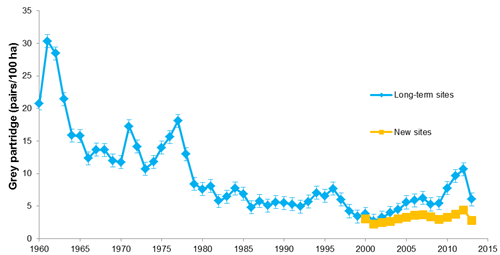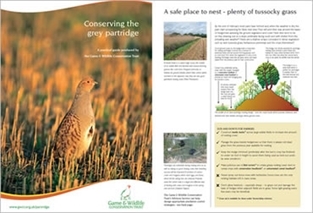Key finding
- UK grey partridge bags are lower now than at any time during the last 200 years.
The decline in numbers of grey partridges in the UK, and indeed across Europe, is well recognised. The UK government officially monitors national bird abundance through the British Trust for Ornithology (BTO)’s Breeding Bird Survey, which has documented a decline in numbers of grey partridge of 91% from 1967 to 2010.
The magnitude of the decline led to the grey partridge being declared a UK Biodiversity Action Plan (BAP) priority bird species, and we were nominated as lead partner. In 2006 a review and revision of the grey partridge targets, extended the original time frame in which to achieve them. These revised targets aimed to ensure that the population would be 160,000 breeding pairs by 2020 and expand the range of the grey partridge across the UK from the 1,450 occupied 10 km squares, to 1,610 by 2020. The UK Post-2010 Biodiversity Framework has replaced the target-led approach of the BAP. Unfortunately for grey partridge conservation, despite the successful recovery of the GWCT’s demonstration at Royston and individual farm successes, recent estimates indicate that the number of breeding pairs has fallen further (here). There are an estimated 43,000 breeding pairs remaining in the UK, although the latest BTO figures indicate that numbers in England might have stabilised by the spring 2012 (here).
Thanks to members of the GWCT two longest-running monitoring schemes, we have information on how numbers of grey partridges have changed. One is the Partridge Count Scheme (PCS) based on counts of live birds on farms etc. that want to improve grey partridge conservation on their ground. This scheme is open to all and, in return for information based on counts undertaken on their ground; PCS members receive site-specific management guidance to improve numbers.
Since 1950, a core group of a few hundred farms and shoots had contributed data about their grey partridge spring pair density to the PCS. After 1998, the PCS expanded to include other farms and land managers who, although not concerned with grey partridge as a game species, still wanted to conserve their birds and contribute to increasing UK numbers. Currently about 1000 farms, shoots and estates from across the country participate in the PCS.
Taking into account changing site participation, Figure 1 shows long-term and current breeding abundance (spring pairs per 100 ha). The pattern in abundance decline, reflecting BTO data over the same period, reveals that densities until 1999-2001 averaged just 17% of what was recorded in the early 1960s, a decline of 83% in 40 years. Since 2001, grey partridge abundance has increased slowly in most years on both long-term and new sites, with notable exceptions in 2008, 2009 and 2013. The years with low abundance reflect conditions the previous summer, with 2007, 2008 and particularly 2012 having low chick productivity that feed into lower breeding abundance the following spring.
Figure 1: Grey partridge index of spring pair density 1960-2013 from the Partridge Count Scheme

The other source is the National Gamebag Census, which contains information on numbers of partridges shot per unit area. Based on information extracted from game books, several bag series extend back over 200 years, so that the census provides a unique insight into much longer historical trends (noting that bags reflect shooting effort as well as partridge abundance). Read more about the NGC grey partridge records in Data back to Darwin.
So what is the current situation, particularly with respect to the BAP targets? Since 1999, the PCS has been expanded as part of our commitment to the UK Grey Partridge Biodiversity Action Plan. The annual pattern of change in spring pair density is similar for long-term contributors and new recruits (Figure 1).
As well as just monitoring partridge numbers, the PCS also returns site-specific guidance to help improve habitat and management. Following its 1999 expansion, both long-term and new sites show periods of encouraging increases in spring densities. Densities increased from 2000 to 2007, for instance, averaging +12% per year. This differs from the BTO’s Breeding Bird Survey for the period of 1995 to 2011 that showed a 53% decline over this period. Despite weather-related setbacks recorded in 2008 and 2009, by spring 2012 the PCS recorded pair densities that had surpassed those seen during the 1980s. Unfortunately, the wet summer of 2012 killed off most chicks and, despite reasonable over-winter survival that winter, by spring 2013 both long-term and new sites saw pair density indices fall by 43% and 36% respectively, taking abundance levels back 3 to 4 years.
We are hopeful for the future, as our data suggest that farms in the Partridge Count Scheme can halt and reverse the decline. The key is to identify what factors are limiting progress on their ground and put in management to address this. However, it is worth bearing in mind that prolonged adverse weather conditions at specific times of year (in particular nesting & brood rearing) can have enormous impact on numbers, at least in the short term.
Further reading
- Aebischer, N.J. & Ewald, J.A. (2010). Grey Partridge Perdix perdix in the UK: recovery status, set-aside and shooting. Ibis, 152: 530-542.
- Ewald, J.A., Aebischer, N.J., Richardson, S.M., Grice, P.V., & Cooke, A.I. 2010. The effect of agri-environment schemes on grey partridges at the farm level in England. Agriculture, Ecosystems and Environment, 138: 55-63.
- Ewald, J.A., Kingdon, N.G., & Santin-Janin, H. 2009. The GWCT Partridge Count Scheme: a volunteer-based monitoring and conservation promotion scheme. In: Cederbaum, S.B., Faircloth, B.C., Terhune, T.M., Thompson, J.J. & Carroll, J.P. (eds) Gamebird 2006: Quail VI and Perdix XII: 27-37. Warnell School of Forestry and Natural Resources, Athens, USA.
- Aebischer, N.J. & Ewald, J.A. 2004. Managing the UK Grey Partridge Perdix perdix recovery: population change, reproduction, habitat and shooting. Ibis, 146 Supplement 2: 181-191.
Get your FREE Grey Partridge Conservation Guide
An essential guide to conserving the grey partridge produced by the Game & Wildlife Conservation Trust.
What's inside your FREE guide
✓ The decline of a common farmland bird
✓ A safe place to nest - plenty of tussocky grass
✓ Chick survival - insect food is crucial
✓ Surviving winter and spring - food and cover
✓ Conservation targets - Partridge Count Scheme
✓ Grey partridges and shooting
✓ Common questions
Download guide now >